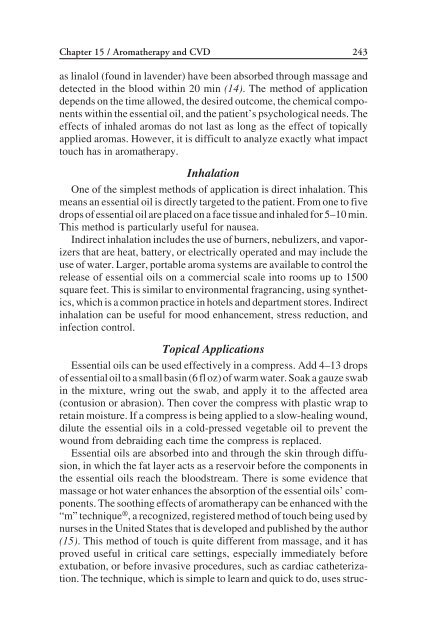Complementary Alternative Cardiovascular Medicine
Complementary Alternative Cardiovascular Medicine
Complementary Alternative Cardiovascular Medicine
You also want an ePaper? Increase the reach of your titles
YUMPU automatically turns print PDFs into web optimized ePapers that Google loves.
Chapter 15 / Aromatherapy and CVD 243<br />
as linalol (found in lavender) have been absorbed through massage and<br />
detected in the blood within 20 min (14). The method of application<br />
depends on the time allowed, the desired outcome, the chemical components<br />
within the essential oil, and the patient’s psychological needs. The<br />
effects of inhaled aromas do not last as long as the effect of topically<br />
applied aromas. However, it is difficult to analyze exactly what impact<br />
touch has in aromatherapy.<br />
Inhalation<br />
One of the simplest methods of application is direct inhalation. This<br />
means an essential oil is directly targeted to the patient. From one to five<br />
drops of essential oil are placed on a face tissue and inhaled for 5–10 min.<br />
This method is particularly useful for nausea.<br />
Indirect inhalation includes the use of burners, nebulizers, and vaporizers<br />
that are heat, battery, or electrically operated and may include the<br />
use of water. Larger, portable aroma systems are available to control the<br />
release of essential oils on a commercial scale into rooms up to 1500<br />
square feet. This is similar to environmental fragrancing, using synthetics,<br />
which is a common practice in hotels and department stores. Indirect<br />
inhalation can be useful for mood enhancement, stress reduction, and<br />
infection control.<br />
Topical Applications<br />
Essential oils can be used effectively in a compress. Add 4–13 drops<br />
of essential oil to a small basin (6 fl oz) of warm water. Soak a gauze swab<br />
in the mixture, wring out the swab, and apply it to the affected area<br />
(contusion or abrasion). Then cover the compress with plastic wrap to<br />
retain moisture. If a compress is being applied to a slow-healing wound,<br />
dilute the essential oils in a cold-pressed vegetable oil to prevent the<br />
wound from debraiding each time the compress is replaced.<br />
Essential oils are absorbed into and through the skin through diffusion,<br />
in which the fat layer acts as a reservoir before the components in<br />
the essential oils reach the bloodstream. There is some evidence that<br />
massage or hot water enhances the absorption of the essential oils’ components.<br />
The soothing effects of aromatherapy can be enhanced with the<br />
“m” technique ® , a recognized, registered method of touch being used by<br />
nurses in the United States that is developed and published by the author<br />
(15). This method of touch is quite different from massage, and it has<br />
proved useful in critical care settings, especially immediately before<br />
extubation, or before invasive procedures, such as cardiac catheterization.<br />
The technique, which is simple to learn and quick to do, uses struc-


